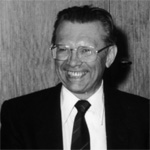Winning approval
Herwig Schopper came to CERN in the early 1970s to head the Nuclear Physics Division. Then, after chairing the directorate of the German nuclear research centre DESY for several years, he returned to CERN in 1981, where he was Director-General during the approval and construction of the Large Electron Positron collider.
 “My first personal experience with LEP was a rigorous examination in the Committee of Council. One delegation was against my nomination as Director-General suspecting that I would favour the German DESY site for LEP instead of CERN. After I had explained my intentions the delegate concerned received new instructions by telephone during a coffee break; I was elected unanimously, and the approval procedure for LEP could start.
“My first personal experience with LEP was a rigorous examination in the Committee of Council. One delegation was against my nomination as Director-General suspecting that I would favour the German DESY site for LEP instead of CERN. After I had explained my intentions the delegate concerned received new instructions by telephone during a coffee break; I was elected unanimously, and the approval procedure for LEP could start.
While the approval of LEP was still pending, Margaret Thatcher visited CERN. On her arrival she told me that she wanted to be treated as a fellow scientist and not as Prime Minister. She surprised me with the question why we intended to build a circular machine instead of two opposing linear colliders, a very pertinent question and proving her excellent briefing for the visit.
Indeed it is a delicate matter of optimization which of the two options is more favourable for a certain beam energy. I explained to her that in the case of LEP a circular machine was more cost effective. She accepted the argument and asked how big the tunnel would be for the next project after LEP. To my reply that the LEP tunnel would be the last ring at CERN she retorted: “Why should I believe you? When I visited CERN the first time John Adams told me that the SPS tunnel would be the last.” Nevertheless, she stated at a press conference that she had been convinced that the funds at CERN were used efficiently, and subsequently the United Kingdom approved LEP.
In the beginning, LEP met considerable opposition in the nearby population. We discovered that this was due to a lack of information, many people believing that the ‘N’ in CERN had something to do with nuclear power. To improve this situation, many senior CERN staff members spent an incredible amount of time giving lectures in all the neighbouring villages.
However, I was particularly worried when Denis de Rougemont, a well known Swiss writer, published articles claiming that LEP was inhuman, gigantic and not necessary for society. This was a surprise since de Rougemont had founded the ‘Centre européen de la culture’ immediately after the war, where politicians discussed how European scientists could learn to work peacefully together again. This political initiative, little known, was one of the channels that led to the foundation of CERN, the other one originating from physicists. I invited de Rougemont to lunch where we discussed his objections; in the end we resolved the difficulties, and I promised to explain his essential role for the creation of CERN at a public debate.
We always tried to take decisions on the basis of rational arguments. However, in the case of deciding on the location of the two experiments ALEPH and DELPHI this method failed. So it was agreed that a coin would be flipped. At a Directorate meeting this act was performed in the presence of the two spokesmen, Jack Steinberger and Ugo Amaldi. After tossing the coin, Jack, being a very careful experimentalist, checked whether the coin had indeed two different sides.”

